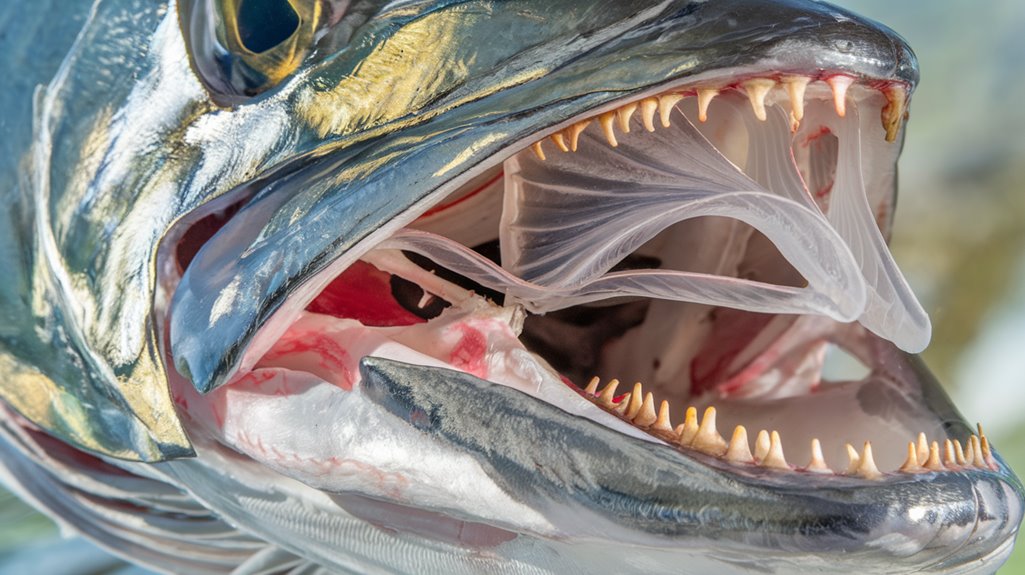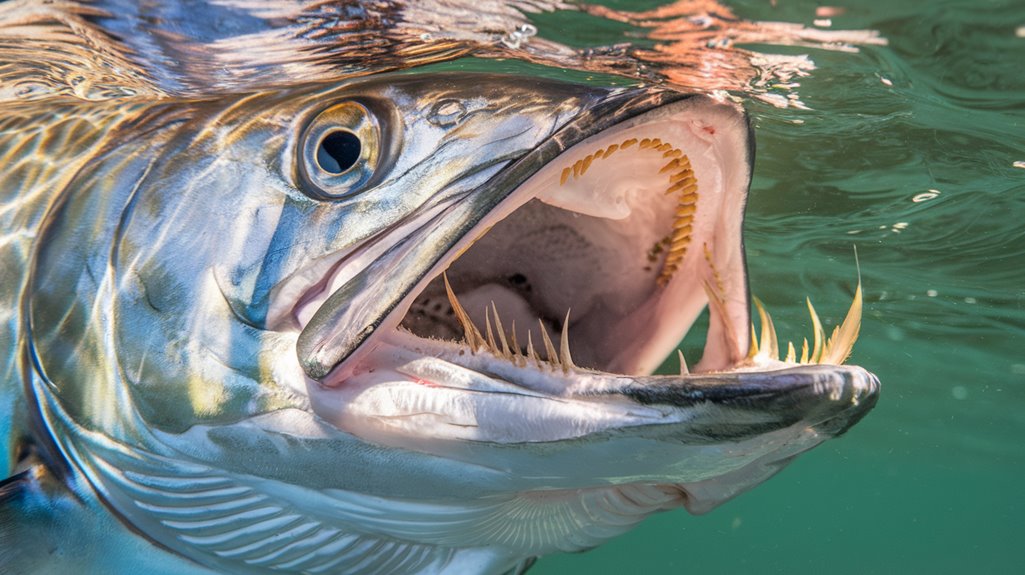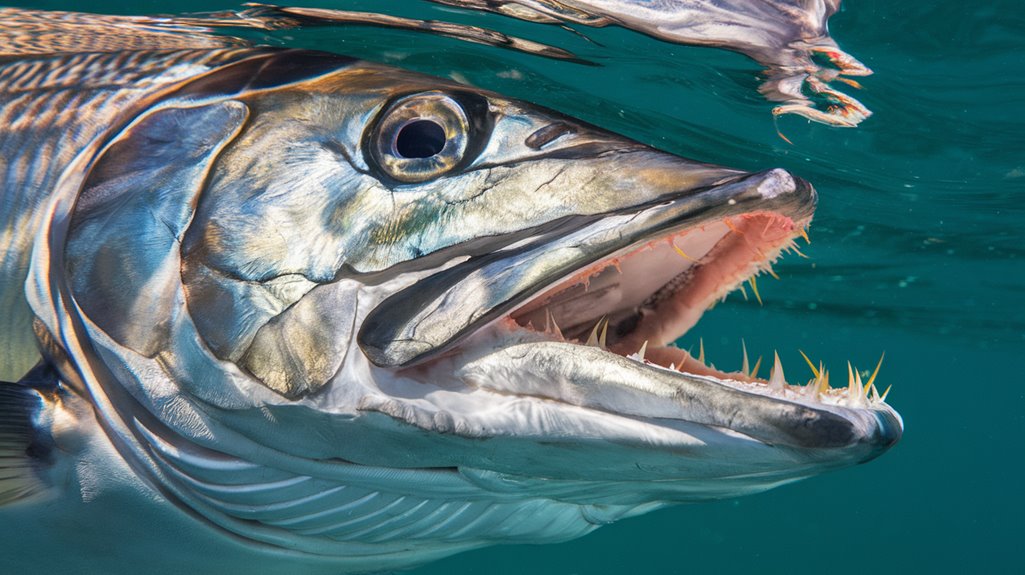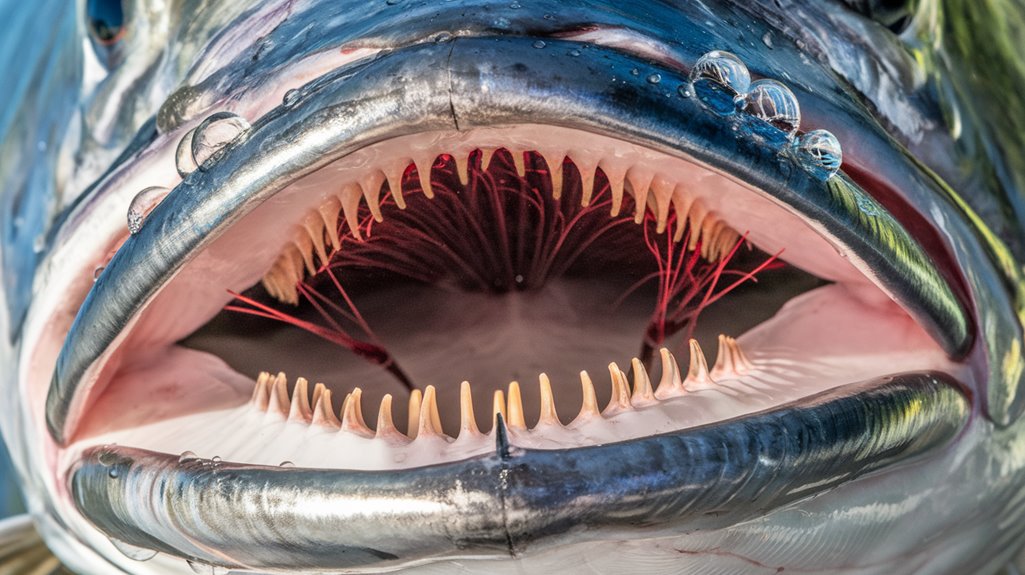You'll find the tarpon's mouth structure represents one of nature's most sophisticated feeding mechanisms. This remarkable apparatus combines a tripartite maxillary system with specialized premaxillaries that work in precise coordination. While you might observe the external features of this predator's imposing jaw, it's the internal architecture that holds the key to understanding its exceptional hunting prowess. The secrets behind this evolutionary masterpiece extend far beyond what meets the eye.
- Key Takeaways
- Anatomy of the Tarpon's Unique Jaw Design
- The Role of Maxillaries in Feeding Behavior
- Understanding the Bony Mouth Structure
- Superior Jaw Adaptations for Survival
- Lower Jaw Components and Mechanics
- Dental Characteristics and Prey Capture
- Evolution of the Tarpon's Mouth Architecture
- Impact of Jaw Structure on Sport Fishing
- Mouth Adaptations for Air-Breathing Capability
- Frequently Asked Questions
- Conclusion
Key Takeaways
- Tarpon possess a unique three-part maxillary bone structure extending beyond the eye, optimizing their predatory efficiency and feeding capabilities.
- The fused premaxillaries create a non-protractile jaw, providing exceptional stability but requiring specialized gulping techniques for feeding.
- Paired dentary bones unite anteriorly to form a robust lower jaw structure, enhancing prey capture strength.
- The mouth's terminal positioning and wide gape allow diverse prey options while facilitating efficient surface feeding.
- Bony maxillaries and specialized jaw architecture enable both effective prey capture and air-breathing capabilities in oxygen-poor environments.
Anatomy of the Tarpon's Unique Jaw Design

While many fish species possess relatively simple jaw structures, the tarpon exhibits a sophisticated oral architecture that makes it both a formidable predator and a challenging catch for anglers. You'll find that the tarpon's mouth features a complex arrangement of three-part maxillary bones extending beyond the eye, coupled with fused premaxillaries that don't protract. The fish's mouth is distinguished by its large terminal position and bony composition, while paired dentary bones in the lower jaw unite at their anterior ends. This intricate configuration, enhanced by a bony gular plate, enables the tarpon to effectively capture and consume prey like shrimp and baitfish. You'll notice that this sophisticated oral structure also makes it difficult for you to set hooks effectively during fishing encounters.
The Role of Maxillaries in Feeding Behavior
When you examine a tarpon's feeding mechanism, you'll notice the maxillaries' distinctive three-bone structure extending posterior to the orbital cavity, which provides ideal mechanical advantage during prey capture. The non-protractile nature of these maxillary bones necessitates a specialized gulping technique, where the tarpon must position itself precisely to engulf prey through rapid jaw movements. The solid osseous composition of the maxillaries enables efficient surface feeding on smaller prey items, though this same structural rigidity presents specific challenges for anglers attempting to set hooks effectively.
Maxillary Extension During Feeding
The tarpon's specialized maxillary structure extends beyond its eye, creating a remarkable feeding mechanism that enables efficient prey capture. You'll notice this maxillary extension facilitates a wide-mouthed gulping action, essential for surface feeding. When pursuing prey, the three-bone maxillary configuration works in concert with fused premaxillaries to form an effective barrier.
| Feature | Function |
|---|---|
| Extended Maxillary | Enables larger mouth opening |
| Three-Bone Structure | Enhances gulp efficiency |
| Posterior Position | Reduces water resistance |
| Fused Premaxillaries | Creates solid prey barrier |
| Surface Adaptation | Optimizes ambush feeding |
This unique anatomical design presents challenges for anglers targeting hooked tarpon, as the fish can manipulate prey within its mouth without immediately encountering the hook, often resulting in missed strike opportunities during the initial feed.
Bone Structure And Movement
A remarkable trio of bones forms the tarpon's maxillary structure, consisting of one maxilla and two supramaxillae that work in concert to create an exceptionally wide gape. You'll notice this specialized mouth architecture extends past the eye in mature specimens, optimizing their predatory efficiency when pursuing fast-moving prey.
The tarpon's bone structure features distinctive fused premaxillaries that remain stationary rather than protruding outward. This non-protractile configuration, combined with the flesh-covered solid bone structure, creates a unique feeding mechanism. When you're analyzing the tarpon's mouth biomechanics, you'll find this arrangement considerably influences their prey capture success. However, it's also why you'll see lower hook-up rates during angling, as the substantial bone structure can prevent fish from detecting hooks while engulfing bait.
Prey Capture Mechanics
Through synchronized movement of their tripartite maxillary system, tarpons execute precise prey capture mechanics that maximize their feeding success. You'll observe how their extended maxillaries, reaching beyond the eye, create a powerful structural framework that's essential for securing prey. The solid bone composition enables rapid mouth closure, while the fused premaxillaries facilitate an expansive gape.
| Maxillary Function | Prey Capture Effect |
|---|---|
| Extended Reach | Enhanced Strike Range |
| Bone Solidity | Secure Prey Grip |
| Wide Gape | Diverse Prey Options |
| Rapid Closure | Efficient Engulfing |
The tarpon's specialized gulping strategy, powered by this sophisticated maxillary arrangement, allows you to witness their remarkable ability to engulf prey from various water columns. This feeding mechanism proves particularly effective when targeting mobile prey like baitfish or benthic organisms such as crustaceans.
Understanding the Bony Mouth Structure
Distinctive in its complexity, tarpon's bony mouth architecture presents a sophisticated arrangement of interconnected skeletal elements. You'll find a unique maxillary structure composed of three distinct bones extending past the eye, complemented by fused premaxillaries that aren't protractile. When you're targeting these fish with a fluorocarbon leader, you'll need to understand how this anatomy affects hook placement.
Key structural components include:
- A terminal superior mouth with extensive bone reinforcement
- Large paired dentary bones with anterior fusion
- A protective gular plate situated between dentaries
This intricate skeletal framework creates significant challenges for hook penetration, requiring you to adapt your angling techniques. The bony mouth structure's engineering explains why tarpon can easily throw hooks and why precise hook placement becomes essential for successful landings.
Superior Jaw Adaptations for Survival

Superior jaw adaptations in tarpon represent evolutionary refinements that maximize both feeding efficiency and survival potential. You'll notice the mouth structure features three distinct maxillary bones extending beyond the eye, creating a robust framework for prey capture. The non-protractile mouth, formed by fused premaxillaries, enhances your understanding of how tarpons efficiently gulp both air and prey.
The lower jaw's design incorporates large dentaries reinforced by a bony gular plate, demonstrating remarkable feeding efficiency. This specialized configuration allows you to observe how the species has developed ideal prey-capture capabilities. The terminal positioning of the mouth, combined with its bony components, showcases an intricate system that's specifically adapted for securing slippery prey like shrimp and small fish, illustrating nature's precision in evolutionary design.
Lower Jaw Components and Mechanics
You'll find that a tarpon's lower jaw gains exceptional strength from its paired dentary bones, which fuse at the anterior midline to create a robust foundation for prey capture. The posterior articular bones work in concert with the dentaries, facilitating the precise jaw movements required during the fish's feeding activities. This architectural combination, reinforced by the gular plate between the dentaries, creates an efficient mechanical system that enables powerful gripping action while handling slippery prey.
Dentary Bone Fusion
Within the complex oral architecture of tarpon, the paired dentary bones form a remarkable structural foundation through their anterior fusion at the jaw's midline. This dentary bone fusion creates an exceptionally robust lower jaw structure, enhanced by the presence of a stabilizing gular plate and complementary articular bones.
Key biomechanical features of the dentary fusion:
- Creates a formidable barrier that greatly impacts hook penetration during sport fishing encounters
- Provides essential structural integrity for the tarpon's feeding mechanisms
- Works in conjunction with the gular plate to maintain jaw stability during prey capture
You'll find this fusion particularly important as it exemplifies the evolutionary adaptations that make tarpon such effective predators. The merged dentaries, combined with supporting skeletal elements, create an ideal balance between strength and functionality in the lower jaw.
Articular Bone Function
Located posterior to the dentaries, the articular bones serve as essential mechanical components in the tarpon's lower jaw assembly. You'll find these smaller bones playing an important role in facilitating jaw movements during feeding activities, working in concert with the fused dentaries and gular plate to create an efficient prey-capture system.
The articular bones' positioning and functionality greatly impact the hook-setting process when you're fishing for tarpon. Their unique structural arrangement affects how the fish responds to bait presentation and hook penetration. Understanding these anatomical features is imperative because they influence the tarpon's feeding mechanics and your fishing success rate. The articular bones' integration with other jaw elements creates a complex biomechanical system that's perfectly adapted for the tarpon's predatory lifestyle.
Dental Characteristics and Prey Capture

The tarpon's distinctive mouth structure features a complex arrangement of fused bones that creates a highly specialized feeding apparatus. You'll find the jaw mechanics particularly fascinating, as fused premaxillaries limit protraction while enabling efficient prey capture. The maxillaries extend beyond the eye, working in concert with the bony gular plate to hold Tarpon's preferred prey securely.
Key adaptations for successful feeding include:
- Fused dentaries at anterior ends providing enhanced grip stability
- Three-bone maxillary structure allowing wide gape potential
- Specialized bony gular plate stabilizing captured prey
These anatomical features create such an effective prey-capture mechanism that tarpon can often engulf their food without detecting fishing hooks. The combination of strong jaws and specialized bone structure enables them to efficiently capture slippery prey like mullet and crustaceans.
Evolution of the Tarpon's Mouth Architecture
Over the span of 120 million years, tarpon's mouth architecture has evolved into a remarkably specialized feeding apparatus that exemplifies their adaptation as ambush predators. You'll find their mouth structure exhibits distinct evolutionary trade-offs, particularly in the fusion of non-protractile premaxillaries and the extended maxillaries that reach beyond the eye socket. These adaptations enhance their ability to capture diverse prey but create unique challenges for hook setting during angling activities.
The development of large paired dentary bones, combined with a robust gular plate in the lower jaw, demonstrates the species' evolutionary refinement for efficient feeding. This specialized configuration enables you to observe how the tarpon's terminal mouth positioning and bony structure optimize their predatory success, particularly when pursuing prey such as shrimp, crabs, and bait fish.
Impact of Jaw Structure on Sport Fishing
Understanding tarpon's specialized jaw architecture presents considerable challenges for sport fishing enthusiasts, with anatomical features directly impacting hook-setting success rates. The fused premaxillaries and elongated maxillaries create a formidable barrier when you attempt to set the hook effectively.
Key technical considerations for tarpon fishing success:
- Circle hooks optimize hook placement exterior to the bony mouth structure, reducing line chaffing and increasing retention rates
- Compensating for the 63% hook-dislodgement rate requires precise bait selection aligned with jaw biomechanics
- Hook penetration depth must overcome the dense osseous composition of the jaw during the fish's acrobatic maneuvers
You'll need to adapt your technique to account for the tarpon's powerful chewing action and bony mouth structure, as these anatomical features considerably influence your ability to maintain hook placement throughout the fight.
Mouth Adaptations for Air-Breathing Capability
While most fish rely solely on gill respiration, tarpon possess remarkable mouth adaptations that enable dual-mode breathing through atmospheric air intake and conventional gill mechanisms. You'll notice their terminal, superior mouth orientation optimizes surface air gulping, while their fused, non-protractile premaxillaries create the powerful suction necessary for this air-breathing capability. When you catch a tarpon, you'll observe how their bony maxillaries, extending beyond the eye, facilitate both aerial respiration and prey capture. This specialized mouth structure works in concert with their modified swim bladder, which functions as a primitive lung. These adaptations allow tarpon to thrive in oxygen-depleted environments where other fish species struggle, as they can efficiently supplement their oxygen intake through surface breathing.
Frequently Asked Questions
What Is the Anatomy of a Tarpon's Mouth?
You'll find the tarpon's terminal mouth features three maxillary bones extending past the eye, fused premaxillaries, paired dentary bones, posterior articular bones, and a bony gular plate between dentaries.
What Kind of Teeth Does Tarpon Have?
You'll find tarpon don't have conventional teeth but possess pharyngeal teeth, which are small, bony structures located in their throat that function to grind and process captured prey.
Can You Hold Tarpon by the Mouth?
You shouldn't hold tarpon by the mouth, as their fused premaxillaries and extended maxillaries are susceptible to damage. Their bony jaw structure requires full-body support during handling to prevent organ injuries.
What Are Some Interesting Facts About Tarpon?
You'll find that tarpon can gulp atmospheric oxygen through their swim bladder, live up to 80 years, grow beyond 8 feet long, and possess prehistoric scales that've remained unchanged for 100 million years.
Conclusion
You'll find that the tarpon's sophisticated maxillary mechanism, coupled with its fused premaxillaries and robust dentary bones, represents a remarkable evolutionary adaptation. The three-part maxillary system you're examining demonstrates ideal biomechanical efficiency for prey capture, while the gular plate facilitates dual-mode respiration. Together, these anatomical features constitute a highly specialized osteological complex that's revolutionized our understanding of teleost feeding mechanisms.

